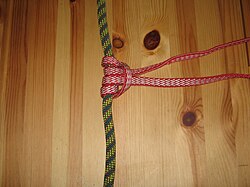(+trans) |
(Marked this version for translation) |
||
| Line 1: | Line 1: | ||
| − | <noinclude><translate></noinclude> | + | <noinclude><translate><!--T:1--> |
| + | </noinclude> | ||
{{Knot | {{Knot | ||
| name=Prusik knot | | name=Prusik knot | ||
| Line 5: | Line 6: | ||
| use = A '''Prusik (aka Prussik or Prussic)''' is a friction hitch used in climbing, canyoneering, caving, rope rescue and by arborists to grab a rope (sometimes referred to as a ''rope-grab''). The term '''Prusik''' is used both for the knot, for the loops of cord, and for the action ('''to prusik'''). | | use = A '''Prusik (aka Prussik or Prussic)''' is a friction hitch used in climbing, canyoneering, caving, rope rescue and by arborists to grab a rope (sometimes referred to as a ''rope-grab''). The term '''Prusik''' is used both for the knot, for the loops of cord, and for the action ('''to prusik'''). | ||
| + | <!--T:2--> | ||
A Prusik rope is a circular loop with a circumference of {{units|20 to 100 cm|8-40 inches}} depending on its intended use. Two Prusik ropes are tied to another rope which is anchored above. When the Prusik knot is under tension, it grabs the rope to which it is tied. When not under tension, it is easily moved. The climber places one foot into each loop, and shifts all of his or her weight to one of them, releasing the tension on the other. The rope without tension is then slid upwards on the vertical rope. The climber the shifts his or her weight to the other loop and slides the first one up. This is repeated until the rope has been ascended. | A Prusik rope is a circular loop with a circumference of {{units|20 to 100 cm|8-40 inches}} depending on its intended use. Two Prusik ropes are tied to another rope which is anchored above. When the Prusik knot is under tension, it grabs the rope to which it is tied. When not under tension, it is easily moved. The climber places one foot into each loop, and shifts all of his or her weight to one of them, releasing the tension on the other. The rope without tension is then slid upwards on the vertical rope. The climber the shifts his or her weight to the other loop and slides the first one up. This is repeated until the rope has been ascended. | ||
| + | <!--T:3--> | ||
Prusiks will work around two ropes, even two ropes of different diameters. Prusiks provide a high-strength and relatively fail-safe (i.e., they will slip before damaging the rope or breaking) attachment, and are used in some rope-rescue techniques. Prusiks are good to use in hauling systems where multiple rope-grabs may be needed, and where mechanical rope-grabs are not available. | Prusiks will work around two ropes, even two ropes of different diameters. Prusiks provide a high-strength and relatively fail-safe (i.e., they will slip before damaging the rope or breaking) attachment, and are used in some rope-rescue techniques. Prusiks are good to use in hauling systems where multiple rope-grabs may be needed, and where mechanical rope-grabs are not available. | ||
| + | <!--T:4--> | ||
Although the Prusik Climb technique may be called old-school by some, the US Army still includes it in its annual Best Ranger competition. Rangers in the competition routinely make it up a 90 foot rope in under a minute. | Although the Prusik Climb technique may be called old-school by some, the US Army still includes it in its annual Best Ranger competition. Rangers in the competition routinely make it up a 90 foot rope in under a minute. | ||
| tying_instructions = | | tying_instructions = | ||
Revision as of 03:52, 6 November 2014







